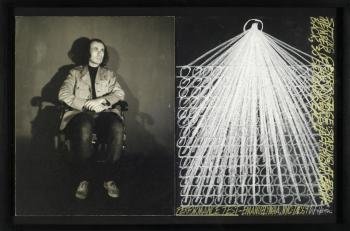After Munch
dal 30/6/2006 al 26/7/2006
Segnalato da
30/6/2006
After Munch
Pollock Fine Art, London
This show connects Munch’s spiritual and personal journey with current art practice.The case of Norwegian contemporary art is especially relevant, as Norwegian artists have all developed under, or just outside the shadow of Edward Munch. The exhibition is accompanied by an introduction by Per Hovdenakk. Formerly the director of the Henie-Onstad Museum in Oslo, he is also an esteemed writer, critic and curator.

introduction by Per Hovdenakk
With an eclectic mix of internationally renowned artists (with six from Norway) Pollock Fine Art is proud to present AFTER MUNCH. This show connects Munch’s spiritual and personal journey with current art practice.The case of Norwegian contemporary art is especially relevant, as Norwegian artists have all developed under, or just outside the shadow of Edward Munch.
The exhibition is accompanied by an introduction by Per Hovdenakk. Formerly the director of the Henie-Onstad Museum in Oslo, he is also an esteemed writer, critic and curator.
'Traditionally, Norwegian artists have not had the courage to establish a close relation to Edward Munch. Instead of cultivating an expressionist tradition, founded by Edward Munch, and important to artists in other countries, Norwegian artists until lately let themselves be inspired and influenced by Matisse and Impressionism. Now, the situation has changed.
'The younger generation of Norwegian artists approach Munch more freely in a direct dialogue. They are inspired by his mythological life as well as the motifs of his paintings and prints. The dialogue can be both critical and satirical, but generally they share Munch's quest for truth and personal freedom in a society structured by limits and restraint.' - Per Hovdenakk
In this exhibition Munch's hand is ubiquities but the transgressive nature of his work is what is most relevant to today’s artists. With an extraordinary life that included episodes of alcoholism, scandal, rehab, nervous breakdowns, free love, fated love affairs and violent gun play, Munch’s story is of pain and redemption but most of all endless questioning.
In 1983 Andy Warhol embarked on a series of works based on the most famous themes of Edward Munch. This exhibition shares that series original title, After Munch. Included is the rare 1983 drawing by Warhol based on Munch’s Madonna. Warhol’s lines seem to relish the opportunity to trace Munch’s hand, but the final effect is fascinatingly varied.
Inspired by Warhol's artist to artist match, this show continues a dialogue with Munch's art. Works in the exhibition that share the transgressive nature of Munch’s output include Bjarne Melgaard’s bronze sculpture of a beheaded man hanging from a Bonsai tree. An image comparable to Munch’s Salome, but with a shocking subject; Norway’s infamous black metal musician and convicted murderer Varg Vikernes. Melgaard ’s works are often assisted by the technological realization of Oslo artist Halvor Bodin. Equally known as an award winning graphic designer, animator, book designer and creator of black metal cd jackets, Bodin’s digital Gothic Romanticism speaks for a new Nordic generation.
Vito Acconci’s work needs no introduction. The piece included in After Munch, Performance Test documents Acconci’s 1969 performance which consisted of him staring at each member of the audience in turn. This meta-portrait brings to mind those suspended encounters found in Munch’s self-portraits.
Vanessa Baird’s work echoes Munch’s penchant for autobiography. Baird’s work can be very raw but somehow remains innocent, especially when combined with her humorous narratives. Like Munch she has portrayed illness, sexuality, dysfunction and the anxiety of daily life.
Snorre Ytterstad's work goes beyond sculpture; obsessive and technically precise,his objects,devices and installations are poised where poetry meets with cool concept. His simple titles are twisted by extended physical manifestations, bound by their own pure processes. Hand to Mouth, refers to Bruce Nauman’s seminal fiberglass sculpture. Ytterstad’s version is less then one inch high, composed of three small plastic toy parts (arm, hand, and cartoon mouth). Like Munch’s Between the Clock and the Bed, each component seems to mark a final measure of dignity.
Incredibly, American-born/second generation Norwegian Robert Hawkins 1985 painting of a glacier was hanging over Jean Michel Basquiat’s bed when he died. Hawkins returns to Nordic themes for this exhibition with only slightly less morbid results. His painted sea oozes primordial currents that on closer inspection are an infinite bed of bleached bones. Basquiat was also a collector and champion of New Yorker Outtara Watts, whose work's African roots are at ease with the dichotomy of logic versus irrationality. Magic has been one of his major themes, an aspect shared with Munch’s noted ‘primitivism’.
SOlve SundsbO is best known as a top fashion photographer. His work goes beyond fire and ice and is informed by a latent sexuality balanced by ethereal beauty. Considering himself an image-maker first and a photographer after, SundsbO pushes the envelope inventing new forms of portraiture and landscape. Lotte Kunow Lund varies the theme from Madonna with bizarre substitutions mutating from one feminine stereotype to another. The artist seems to be questioning Munch’s own views on woman in the process.
Edward Munch's work is a rare phenomenon; a one-person art movement. This exhibition is homage to his telekinetic ability to move inanimate paint. To quote The Scream…
’I was walking along a path with two friends - the sun was setting - suddenly the sky turned blood red - I paused, feeling exhausted, and leaned on the fence - there was blood and tongues of fire above the blue-black fjord and the city - my friends walked on, and I stood there trembling with anxiety - and I sensed an infinite scream passing through nature.’ Edward Munch
Private view: Friday June 30th 6-8 p.m.
Pollock Fine Art
58a King Henry's Road - London



